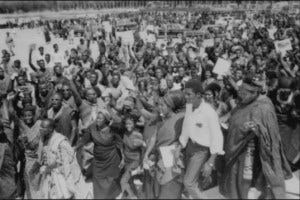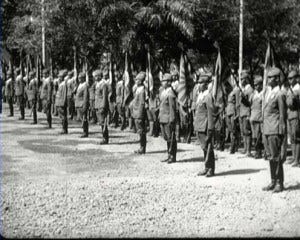World War II Colonial Soldiers and the Demand for Independence
Ghana Accra Protests
In February 1948, two thousand former soldiers who served in the Gold Coast Regiment in World War II (WWII) marched against the government they had defended three years ago. The veterans were incredibly well organized, coming from different regions of the country. They demanded “independence, a good living, and good pay.” When the British police fired against the protesters, they did not flee. Instead, the ex-soldiers fought back and successfully entered the city. This event boosted Kwame Nkrumah and the United Gold Coast Convention (UGCC), which played a crucial role in organizing this protest to pressure the British government and demand independence. Later, as we know, Nkrumah became the first president of independent Ghana.
In my forthcoming paper at International Studies Quarterly, I find that the event in Ghana three years after WWII was hardly an outlier. I argue that WWII experiences made soldiers more motivated and prepared to demand independence after the war. Military experiences, which require an individual’s conformity to a prescribed role in group actions, familiarized veterans with organizing social movements after the war. Therefore, veterans, who had grievances (willingness) and the experience of collective action (capacity) to demand independence, played a crucial role in organizing nationalist movements in the post-war period. Ultimately, WWII veterans affected the landscape of nation-states post-WWII era by creating differences in whether the territories without sovereignty would develop an indigenous political power succeeding the colonial rules.
Theory
So, how exactly did the WWII experiences matter in creating nationalist movements in the colonies and dependencies? Studies in political science and psychology have well documented that military experiences reduce the cost of collective actions in the post-war period. One key advantage is that soldiers get accustomed to behaving as a group during military service. Military training and battlefield experiences naturally expose soldiers to organizational hierarchy and individual duties. Scholars reported numerous instances of how experiencing group actions in the military affected later social movements in France, the Soviet Union, the United States, and elsewhere.
Wartime experiences also increased the demand for independence. Scholars pointed out that veterans, in general, are likely to turn against the government after retirement. Veterans demanded economic compensation, including pensions, employment, and social readjustment, in return for their wartime services. However, the colonial governments rarely met their demands. Furthermore, WWII allowed veterans to experience and imagine alternative political and social orders. For instance, historians note that fighting with and against the Europeans helped the African soldiers overcome the idea of racial hierarchy. Returning to their home country, veterans were more likely to resent the discrimination remaining in society, which increased the demand for equal treatment.
WWII experiences, thus, helped provide both the capacity – through reducing the cost of collective action – and willingness – through increasing political and economic grievances – to launch the independence movement in the post-war periods. Therefore, assuming that most veterans returned from the areas they were recruited, we should expect to see nationalist movements develop in sub-national territories with a large concentration of WWII veterans.
Design and findings
I test this argument by drawing on WWII native recruitment and the post-WWII nationalist movements in sub-national territories from 1945 to 1984. Studying this period contributes substantially to our understanding of state formation, especially considering that the number of states born in this period exceeds that in all other periods combined. In fact, most post-war nationalist movements in this period occurred in the first five years after the end of WWII, with the number steadily decreasing over time.
Turning to the recruitment side, the Soviet Union recruited the most among the metropolitan powers, about 6.2 million soldiers outside Russia. Britain and France followed with about 3.3 and 0.8 million soldiers, respectively. The figure below shows that indigenous recruitment in WWII was indeed a global event. Recruitment occurred in most places in Africa and Asia. Pacific islands such as Tonga and Fiji supported Britain with about three thousand soldiers. Even the least affected area, South America, also observed two recruitment cases in British Guiana and Suriname.
In my paper, I find that native military recruitment in WWII increased the likelihood of nationalist movements in the post-war period. A sub-national territory with military recruitment is four times more likely (about 2% to 8%) to develop nationalist movements than ones without, holding other factors constant. Using a continuous measure, I find that a 10% increase in recruitment is associated with about a 32% increase in the probability of the emergence of nationalist movements on average.
This impact of military recruitment is even more striking because recruitment at first should have been less likely to occur in the territories with a growing nationalist sentiment. Colonial powers were concerned about arming and training nationalistic populations because it could increase the risk of armed rebellion. For instance, Japan refrained from conscripting Koreans because it could not trust that they would remain loyal. The figure below shows that the metropolitan powers recruited less from places that had already developed nationalist movements before WWII. This background further highlights the effects of WWII recruitment on nationalist movements, implying that the recruitment completely shifted the landscape of nationalist movements emerging in the colonial world.
I also find that the effect of WWII recruitment decreases over time. Scholars have reported that the effect of military service on collective action persists but is also likely to decline after some time due to socialization, aging, and spatial dispersion. The figure below illustrates that the difference in the predicted probability of nationalist movement onset between the territories with recruitment and those without is significantly different only during the eight years following WWII. The pattern is consistent with the historical accounts describing the post-WWII nationalist uprisings as mostly instantaneous events after demobilization.
Outside Ghana, there is plenty of qualitative evidence that WWII veterans were active in the anti-colonial conflicts and protests. In Kenya and Madagascar, WWII soldiers were dissatisfied with their political and economic status after the war and played a pivotal role in organizing nationalist movements. In Asia, the Japanese military training greatly influenced independence movements in the former European colonies. The Japanese emphasized the norm of self-discipline and endurance in group actions to indigenous recruits. So-called independence armies, raised during the Japanese occupation period, played a key role in leading independence wars in many former colonies in Southeast Asia, including Indonesia.
Colonial military, nationalist movements, and beyond
The 20th century was the era of new nation-states. Previous studies often examined the state-births from the colonial powers’ perspective, highlighting the conditions for their decision to grant independence. My research points out that the era of new nation-states began with the rise of nationalist movements worldwide. Given the colonial powers’ reluctance to give freedom to their colonies, nationalist movements played a vital role in creating the international system we see today.
Explaining the origins of nationalist movements, I revisited the idea that “war made states.” However, rather than the accumulation of coercion or resources to finance the cost of war, as much of the literature does, I emphasized a different process linking war to state formation. My research highlights how war contributed to the demand for new statehood by shaping veterans’ political preferences.
My research leaves open for further study the question of how colonial military recruitment, in general, influenced politics beyond generating nationalist movements. One important research area would focus on how the colonial powers used and managed ethnic differences in their colonies and their later impacts on the new state’s military and government. Given the substantial role of the military in newly independent states, understanding the root of the military in the Global South helps us address the theoretical and empirical problems in civil-military relations we still observe today.
Header image: The Gold Coast Regiment at the Burma Front in World War II. British National Army Museum, Out of Copyright.







